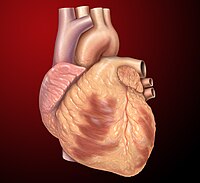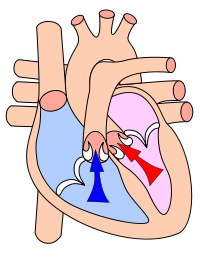
Effects of Red Blood Cell Sickling on Right Ventricular Afterload in vivo
Sign Up to like & getrecommendations! Published in 2021 at "Experimental Mechanics"
DOI: 10.1007/s11340-020-00669-3
Abstract: Background Hemolysis in sickle cell disease (SCD) releases cell free hemoglobin, which scavenges nitric oxide (NO), leading to pulmonary vascular vasoconstriction, increased pulmonary vascular resistance (PVR), and the development of PH. However, PVR is only… read more here.
Keywords: red blood; afterload; cell free; free hemoglobin ... See more keywords

Mechanoelectric coupling and arrhythmogenesis in cardiomyocytes contracting under mechanical afterload in a 3D viscoelastic hydrogel
Sign Up to like & getrecommendations! Published in 2021 at "Proceedings of the National Academy of Sciences of the United States of America"
DOI: 10.1073/pnas.2108484118
Abstract: Significance The heart autoregulates its contractile strength to maintain cardiac output when pumping blood against the mechanical afterload from vascular resistance. Increased afterload in cardiovascular diseases is associated with cardiac arrhythmias. However, the underlying mechanisms… read more here.
Keywords: afterload; mechanical afterload; ca2; viscoelastic hydrogel ... See more keywords

A novel nonlinear afterload for ex vivo heart evaluation: Porcine experimental results
Sign Up to like & getrecommendations! Published in 2022 at "Artificial Organs"
DOI: 10.1111/aor.14307
Abstract: Abstract Background Existing working heart models for ex vivo functional evaluation of donor hearts often use cardiac afterloads made up of discrete resistive and compliant elements. This approach limits the practicality of independently controlling systolic… read more here.
Keywords: aortic pressure; pressure; heart; afterload vivo ... See more keywords

Detection of physiological control inputs preload and afterload from intrinsic pump parameters in total artificial heart.
Sign Up to like & getrecommendations! Published in 2022 at "Artificial organs"
DOI: 10.1111/aor.14481
Abstract: BACKGROUND In the total artificial heart (TAH), the inputs to the physiological control unit, preload, and afterload, are detected from intrinsic pump parameters (e.g., motor current). Within this study, their detection techniques are developed, and… read more here.
Keywords: preload afterload; total artificial; heart; preload ... See more keywords

The Arterial Load and Right Ventricular-Vascular Coupling in Pulmonary Hypertension.
Sign Up to like & getrecommendations! Published in 2021 at "Journal of applied physiology"
DOI: 10.1152/japplphysiol.00204.2021
Abstract: Right ventricular (RV) functional adaptation to afterload determines outcome in pulmonary hypertension (PH). RV afterload is determined by the dynamic interaction between pulmonary vascular resistance (PVR), characteristic impedance (Zc) and wave reflection. Zc and wave… read more here.
Keywords: pulmonary hypertension; afterload; right ventricular; hypertension ... See more keywords

Pulmonary vascular collagen content, not cross-linking, contributes to right ventricular pulsatile afterload and overload in early pulmonary hypertension.
Sign Up to like & getrecommendations! Published in 2017 at "Journal of applied physiology"
DOI: 10.1152/japplphysiol.00325.2016
Abstract: Hypoxic pulmonary hypertension (HPH) is associated with pulmonary artery (PA) remodeling and right ventricular (RV) overload. We have previously uncovered collagen-mediated mechanisms of proximal PA stiffening in early HPH by manipulating collagen degradation and cross-linking… read more here.
Keywords: collagen; collagen content; cross linking; afterload ... See more keywords

An Unwelcome Embrace: Adverse Pulmonary-Aortic Interactions in Pulmonary Hypertension.
Sign Up to like & getrecommendations! Published in 2017 at "Circulation. Cardiovascular imaging"
DOI: 10.1161/circimaging.117.006063
Abstract: Vascular remodeling in pulmonary hypertension (PH) causes increased ventricular afterload, resulting in right ventricular failure and high mortality.1 Afterload is the mechanical impedance imposed by the arterial tree, against which the ventricle must work to… read more here.
Keywords: ventricular afterload; pulmonary hypertension; unwelcome embrace; afterload ... See more keywords

Sex differences in left ventricular afterload and diastolic function are independent from the aortic size
Sign Up to like & getrecommendations! Published in 2019 at "PLoS ONE"
DOI: 10.1371/journal.pone.0214907
Abstract: Background Women have a greater risk of heart failure with preserved ejection fraction (HFPEF) than men do, yet the basis for this disparity remains unclear. Greater arterial stiffness and afterload causes left ventricular (LV) diastolic… read more here.
Keywords: afterload; sex differences; size; sex ... See more keywords

Afterload reduction after non-invasive vagus nerve stimulation in acute heart failure
Sign Up to like & getrecommendations! Published in 2023 at "Frontiers in Human Neuroscience"
DOI: 10.3389/fnhum.2023.1149449
Abstract: Introduction While central blood pressure (BP) has been recognized as a major indicator of left ventricular (LV) afterload, the reduction of central pressure decreases LV afterload and may prevent heart failure (HF) decompensation. Non-invasive transcutaneous… read more here.
Keywords: non invasive; afterload reduction; stimulation; heart ... See more keywords

The Impact of Left Ventricular Performance and Afterload on the Evaluation of Aortic Valve Stenosis: A 1D Mathematical Modeling Approach
Sign Up to like & getrecommendations! Published in 2023 at "Bioengineering"
DOI: 10.3390/bioengineering10040425
Abstract: The transaortic valvular pressure gradient (TPG) plays a central role in decision-making for patients suffering from severe aortic stenosis. However, the flow-dependence nature of the TPG makes the diagnosis of aortic stenosis challenging since the… read more here.
Keywords: aortic stenosis; afterload; performance afterload; stenosis ... See more keywords

Effects of artemisinin on ventricular arrhythmias in response to left ventricular afterload increase and microRNA expression profiles in Wistar rats
Sign Up to like & getrecommendations! Published in 2018 at "PeerJ"
DOI: 10.7717/peerj.6110
Abstract: Background Patients with dilated cardiomyopathy, increased ventricular volume, pressure overload or dysynergistic ventricular contraction and relaxation are susceptible to develop serious ventricular arrhythmias (VA). These phenomena are primarily based on a theory of mechanoelectric feedback,… read more here.
Keywords: response; afterload; group; ventricular arrhythmias ... See more keywords